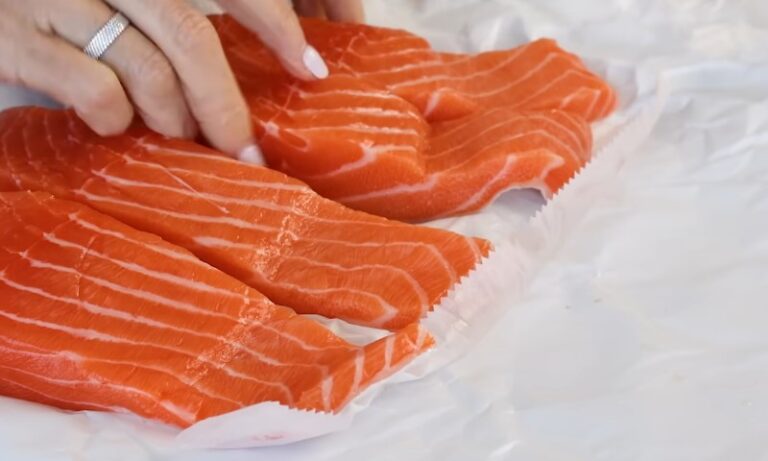Fresh salmon is one of the most rewarding ingredients to cook with, but it also happens to be one of the most fragile. It doesn’t take long for quality to slip, and once it does, it’s not something you can salvage with heat or seasoning.
The good news is that your senses: sight, smell, and touch, will usually give you a clear answer if you know what to look for. Pair that with time and temperature rules from food safety authorities, and you’ll never have to guess.
Key Highlights
- Fresh salmon should smell mild and ocean-like; sour or ammonia odor means discard.
- Bright, moist color and firm texture indicate freshness; dull or slimy surface means spoilage.
- Safe storage: raw 1–2 days, cooked 3–4 days at ≤40°F, frozen up to 3 months for best quality.
- Always cook to 145°F and keep vacuum-packed salmon ≤38°F; when unsure, throw it out.
The Fast Checks Are Sight, Smell, Touch, Time
Before you cook or freeze salmon, quick sensory checks can reveal everything you need to know. Focus on how it looks, smells, feels, and how long it’s been stored.
Smell
The nose is your first defense. Fresh salmon should carry only a mild, briny scent, something that reminds you of clean ocean air. Once it turns sour, rancid, or carries a sharp ammonia edge, the fish is no longer safe.
The U.S. Food and Drug Administration warns consumers to discard any seafood that smells sour, rancid, or overly “fishy.”
Those odors intensify after cooking, not disappear. If your salmon already smells unpleasant before you start cooking, it’s time to throw it out.
Appearance
Color and texture reveal a lot about salmon’s freshness. A bright, moist fillet signals quality, while dull tones or slime warn of spoilage.
Color
Fresh salmon varies naturally in hue, from coral pink in Atlantic species to deep orange in wild Pacific types. A dull surface, brown patches, or an overall gray tint means the flesh is breaking down.
Surface
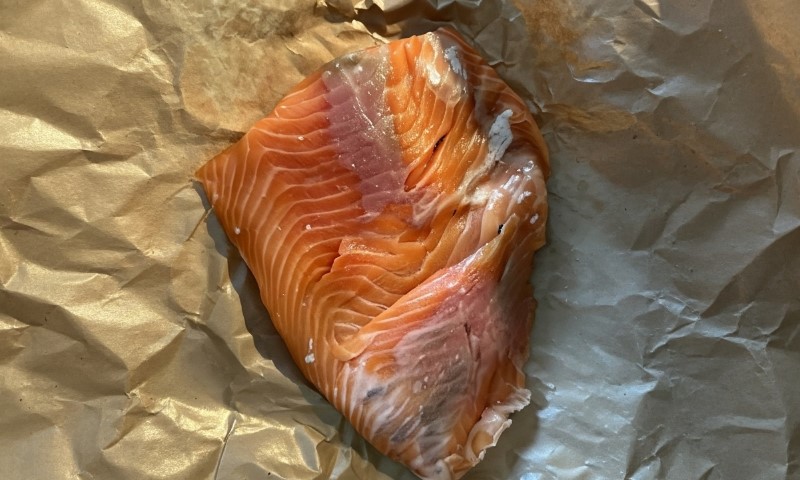
A thin, clear layer of moisture is normal, as it keeps the fillet supple. But if that turns into a cloudy or slimy coating that feels sticky between your fingers, bacterial growth is already active. A slick film is one of the most reliable visual cues of a fish past its prime.
Texture and “Gaping”
When you press the fillet gently, the flesh should spring back cleanly. If it feels soft, mushy, or leaves a dent where your finger was, the structural proteins are breaking down.
Another clue is “gaping,” where the muscle layers start to pull apart in wide sections. Seafood manuals tie this to spoilage and mishandling during transport.
Touch
The texture tells you everything about freshness. A firm piece of salmon will resist your touch and then recover its shape.
If it stays indented or feels tacky instead of slightly moist, it’s no longer good. Sticky flesh often pairs with odor and discoloration, a clear trio of spoilage indicators.
Time and Temperature
Even under perfect refrigeration, salmon has a short clock. The FDA and USDA align on these limits:
| Storage Type | Temperature | Safe Duration | Notes |
| Raw salmon (refrigerated) | ≤ 40°F / 4°C | 1–2 days | Store in the coldest zone, ideally on ice |
| Cooked salmon (refrigerated) | ≤ 40°F / 4°C | 3–4 days | Store in shallow, sealed containers |
| Frozen salmon | 0°F / -18°C | Indefinitely safe, best within 2–3 months | Quality declines beyond 3 months due to oxidation |
Once you pass those windows, discard rather than risk it. No method of cooking can neutralize spoilage bacteria or the toxins they leave behind.
The Rule Behind All Rules
If anything looks, smells, or feels wrong, throw it out. Never taste raw or cooked salmon to “check.” FDA and CDC guidance is explicit: time and temperature control determine safety, not taste or appearance alone.
The Science in Plain Terms
Salmon spoilage isn’t random. It follows clear biological processes driven by bacteria, enzymes, and storage conditions. Here’s how it happens.
Why Odor is Reliable for Most Spoilage
At refrigerator temperatures, spoilage bacteria produce volatile compounds: trimethylamine, ammonia, and other breakdown products, which give off that unmistakable sour or rancid odor.
These gases intensify once heat is applied, which is why a bad-smelling fillet always tastes worse after cooking. Odor doesn’t catch every type of hazard, but it reliably detects decomposition.
Why “Look” and “Feel” Matter
Salmon muscle contains enzymes that start breaking down right after harvest. Over time, bacteria join in, degrading the connective tissue that keeps the flesh firm. As this process continues, surface slime builds up, color fades, and the muscle softens.
Why Reduced-Oxygen Packaging Can Complicate Things
Vacuum-sealed and modified-atmosphere packs slow down normal spoilage, but they also reduce oxygen. Certain bacteria, like Clostridium botulinum, can produce toxins in oxygen-poor conditions even at refrigerator temperatures if the cold chain slips above safe limits.
For that reason, regulators require keeping vacuum-packed salmon at or below 38°F (3°C). If your fridge can’t maintain that, remove the fish from its packaging before refrigerating.
Storage Rules You Should Follow
Keeping salmon safe starts with how you store it. Cold, clean, and sealed are the three rules that protect both quality and safety.
Refrigeration
Keep your salmon cold, really cold. The back or bottom shelf of your fridge is usually the coldest spot. Store raw salmon in a leakproof bag over a tray of ice, and cook it within two days. Cooked salmon should go into shallow containers to cool fast and be eaten within four days.
A refrigerator thermometer is worth a few dollars, as it lets you verify your fridge stays under 40°F. FDA food safety data show that many household fridges run warmer than that without anyone realizing.
Freezing
For longer storage, freeze it immediately at 0°F (-18°C). Air exposure causes freezer burn and flavor loss, so wrap tightly in heavy-duty freezer bags or vacuum-seal.
While frozen salmon stays safe indefinitely, its best flavor and texture hold for about two to three months because fat oxidation slowly changes the taste.
Freezer burn isn’t dangerous; it’s simply dehydration. You can trim off the affected area and cook the rest. The texture may be dry, so it works better in soups or chowders than in pan-seared dishes.
Thawing
Thaw salmon in the refrigerator on a rimmed tray to catch drips. Never leave it on the counter. Room temperature speeds bacterial growth, and fish moves into the “danger zone” (40°F to 140°F) faster than meat.
For vacuum-sealed salmon, follow the package instructions. If your fridge runs warmer than 38°F, remove it from the package before refrigerating or thawing. Keep it cold until cooking time.
Refreezing
If you thawed salmon in the refrigerator and kept it at 40°F or below, you can safely refreeze it. Expect some quality loss in texture. After a power outage, refreeze seafood only if it still has ice crystals or stayed below 40°F; otherwise, discard it.
Cooking Temperature That Ends the Guesswork
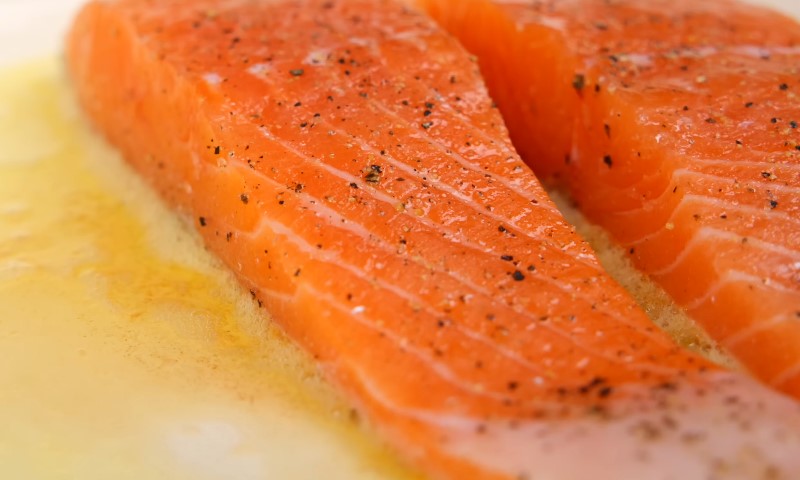
Heat kills pathogens if you reach the right temperature. Cook salmon to 145°F (63°C), or until the flesh turns opaque and flakes easily with a fork. That’s the federal standard for finfish.
A digital thermometer removes the guesswork and ensures uniform doneness. Undercooked areas, especially in thick fillets, can harbor bacteria that survived cold storage.
If your fish smells off during cooking, stop right there. Spoilage odors tend to intensify once heat is applied, and cooking can’t neutralize toxins already present.
Special Cases That Need Extra Care
Certain types of salmon require tighter handling and storage rules. Smoked, cured, or raw versions carry different safety risks that call for extra caution.
Cold-smoked or cured salmon (lox, nova, gravlax)
Cold-smoked and cured salmon are not cooked, which means they can harbor Listeria monocytogenes. The bacteria can survive at refrigerator temperatures. Health authorities recommend that pregnant people, older adults, and those with weakened immune systems avoid refrigerated smoked seafood unless it’s part of a cooked dish. Shelf-stable canned smoked fish, however, is processed for safety and is a better option for high-risk groups.
Raw or undercooked salmon
Raw salmon, as served in sushi or poke, can carry bacteria and parasites. Commercial freezing kills many parasites but not all harmful bacteria.
Proper sourcing from suppliers that handle seafood for raw consumption helps, but cooking remains the safest way to eliminate risk.
What Expiration Labels Really Mean
Date labels on seafood often confuse buyers. They’re about quality, not safety, except for infant formula, which is regulated differently. Here’s how to read them correctly:
| Label | Meaning | What You Should Do |
| Best if Used By / Before | Manufacturer’s estimate of peak flavor and texture | Still safe after date if stored properly |
| Sell By | Inventory control for stores | Not a consumer safety date |
| Use By | Last recommended date for best quality | Check with your senses and storage time, not just the label |
Food authorities encourage relying on time, temperature, and sensory checks instead of printed dates. A package might still look perfect but be unsafe if stored too warm.
Decide If Your Salmon Stays or Goes
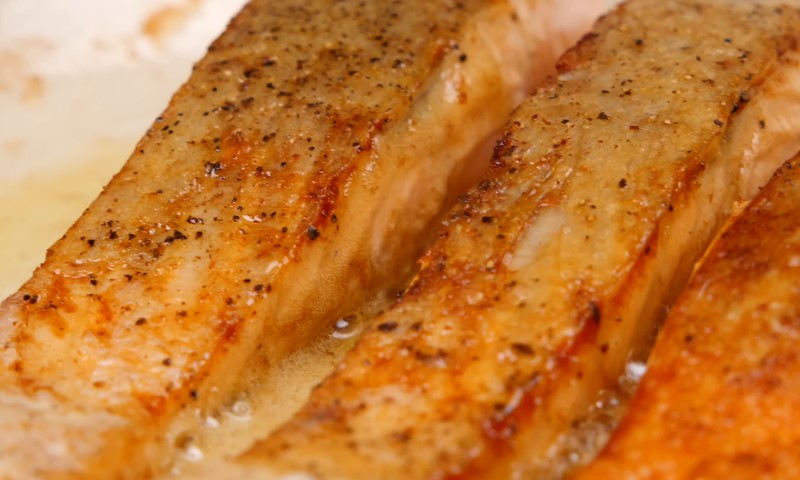
A practical checklist makes decisions quick and consistent:
1. Check storage history
- Raw salmon kept ≤40°F for 1–2 days: okay.
- Longer or uncertain time: discard.
2. Open and smell
- Mild sea scent: safe.
- Sour, rancid, fishy, or ammonia: discard immediately.
3. Inspect color and surface
- Bright, moist, intact flesh: good.
- Dull tone, dark spots, or thick slime: discard.
4. Press for firmness
- Springs back: acceptable.
- Mushy or dented: discard.
5. If frozen
- Frost buildup or dry gray areas = freezer burn.
- Trim and use for soups if smell is still neutral.
6. If vacuum-packed
- Check storage ≤38°F.
- If unsure, open the package before refrigerating.
7. Cook correctly
- Internal temperature of 145°F (63°C).
- Any bad odor during cooking: discard.
That checklist covers nearly every scenario a home cook will face, from fridge storage to thawed vacuum packs.
Buying Habits That Reduce Guesswork
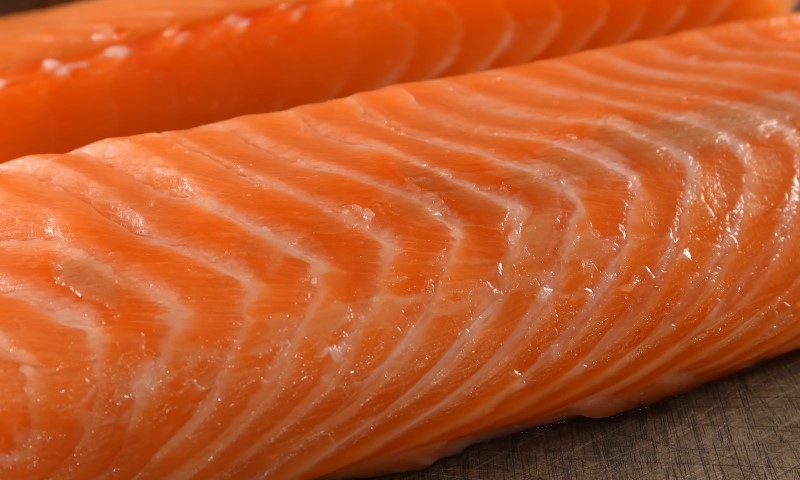
- Buy last on your grocery run to keep fish cold as long as possible.
- Use an insulated bag with ice packs if your trip home takes more than 30 minutes.
- Inspect frozen salmon packaging : avoid broken seals, heavy frost, or flexible “frozen” fillets that feel partially thawed. Those signs indicate temperature abuse.
- Store immediately once home. The faster it gets into the cold, the longer it stays safe.
- Use a refrigerator thermometer to ensure a consistent ≤40°F.
- For vulnerable groups , skip refrigerated smoked salmon unless it’s cooked in a recipe. Canned smoked salmon is safer and shelf-stable.
These small habits eliminate the gray areas that lead to waste or risk.
The Role of Temperature Control at Home
Bacteria responsible for spoilage and illness grow fastest between 40°F and 140°F. The key to safe salmon is keeping it out of that zone. In practical terms, that means:
- Store at ≤40°F at all times.
- Limit counter time during meal prep to under two hours (one hour if your kitchen is above 90°F).
- Preheat pans and ovens so salmon cooks through quickly.
- Use an instant-read thermometer for final checks.
Once you finish eating, refrigerate leftovers within two hours. If you’re packing for later, use shallow containers to cool fast.
Bottom Line
Salmon rewards care and punishes neglect. Rely on your senses, keep your refrigerator cold, and respect the time limits. Smell it first, inspect the surface, feel the firmness, and factor in how long it’s been stored.
Follow the temperature rules: 1–2 days for raw, 3–4 for cooked, 0°F for freezing, and 145°F for cooking. Keep vacuum-packed fish extra cold at 38°F or below. If anything seems off, throw it out without tasting. Your instincts and a thermometer will keep you safe every single time.

